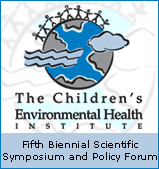| Measurement of Brevetoxin Levels by Radioimmunoassay of Blood Collection Cards after Acute, Long-Term, and Low-Dose Exposure in Mice Ricky Woofter,1 M-Yasmine Bottein Dechraoui,1 Ian Garthwaite,2 Neale R. Towers,2 Christopher J. Gordon,3 José Córdova,4 and John S. Ramsdell1 1Marine Biotoxins Program, Center for Coastal Environmental Health and Biomolecular Research, National Oceanic and Atmospheric Administration, National Ocean Service, Charleston, South Carolina, USA; 2Toxinology, Food Science, AgResearch Ruakura, Hamilton, New Zealand; 3Neurotoxicology Division, National Health and Environmental Effects Research Laboratory, U.S. Environmental Protection Agency, Research Triangle Park, North Carolina, USA; 4Fundación Ciencia Para La Vida, Santiago, Chile
Abstract
We developed a radioimmunoassay (RIA) using a sheep anti-brevetoxin antiserum to evaluate detection of brevetoxin on blood collection cards from mice treated with the brevetoxin congener PbTx-3. The RIA has high affinity for PbTx-3 [half-maximal effective concentration (EC50) ± SE = 1.2 ± 0.2 nM ; n = 10] and recognizes both type 1 and type 2 brevetoxins, but not ciguatoxin. Direct comparison of the RIA with a radiolabeled [3H]-PbTx-3 receptor-binding assay (RBA) revealed excellent sensitivity, congener selectivity, and minimal interference from blood matrix. We first analyzed blood samples from an acute time course exposure, using a maximal nonlethal dose [180 µg/kg body weight (bw) ] for 0.5, 1, 2, 4, and 24 hr. Mean blood brevetoxin levels were 36 nM at 30 min and stayed above 20 nM during the 1-4 hr time points. We next analyzed blood brevetoxin levels after longer exposure (0.5, 1, 2, 3, 4, or 7 days) . Mean blood brevetoxin levels were 26.0 nM at 0.5 days, decreased to 8.2 nM at 1.0 day, and maintained a significant level (p < 0.05) of 1.3 nM at day 2. We next determined the lowest measurable dose using increasing concentrations of PbTx-3 (10-300 µg/kg bw) . Analysis of the blood samples at 60 min revealed a linear relationship between administered and internal doses (r2 = 0.993) . All doses of brevetoxin administered were detectable at 1 hr, with significant levels found for the lowest administered dose of 10 µg/kg bw--a dose that was 10-fold lower than the lowest observable effect level. This RIA provides an optimal first-tier detection of brevetoxin from blood collection cards and, used in combination with the RBA and liquid chromatography-mass spectrometry, should provide a complete panel of methods to biomonitor brevetoxin exposure. Key words: blood, brevetoxin, radioimmunoassay. Environ Health Perspect 111:1595-1600 (2003) . doi:10.1289/ehp.6166 available via http://dx.doi.org/ [Online 2 July 2003]
The full version of this article is available for free in HTML or PDF formats. |

